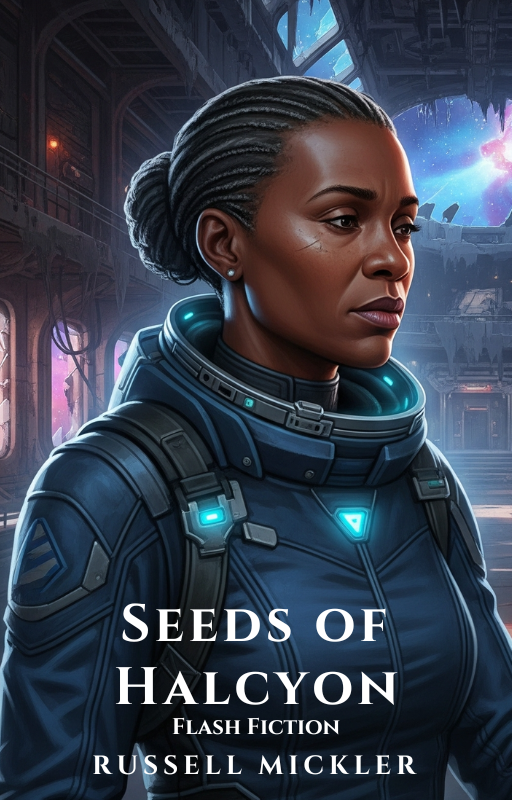Writer’s Playground 11th Challenge
Writer’s Playground is one of the best amateur contests around. I look forward to every contest, and the 11th Challenge — kicked off around July 10 — offered a fun set of prompts.
We had to choose from five possible characters:
A fugitive
A queen
An amputee
A carpenter
A teenage prodigy
… depicted in one of the following settings:
A summer camp
A vineyard
A production studio/film or tv set
A rehabilitation center
A treehouse
… with a static concept that needs to appear in all stories:
A piece of amber with something relating to or derived from living matter preserved in it.
My story, Seeds of Halcyon, takes place both in the distant and not-so-distant future, where humanity faces extinction stemming from its own negligence. Earth is dying, and in a last-ditch attempt to save itself, Mankind constructs an interstellar ark to carry survivors to Kepler-452b, an Earth-like planet orbiting a G-type star similar to our own, located over 1800 light-years away.
The story opens with Dr. Imani Kesebir, a 50+-year-old physicist with a background in interstellar navigation, who is awakened from cryostasis by a desperate AI called Halcyon. The amber stasis solution is depicted elsewhere through the story to meet the prompt.
Haunted by Earth’s ecological collapse and personal tragedy, Imani is the embodiment of Mankind’s hubris and remorse for ruining a perfectly good planet.
Iamni is a rebel, a truth-seeker who deeply rejects the moral cost of the project and questions whether humanity should have a second chance. After the death of her sister from plague, she eventually came to conclude Humanity deserved its evolutionary dead end, and not a “do-over” on a distant world.
Once a leader, a Commander for the Halcyon Project, Imani defied her superiors by sabotaging the mission to prevent humanity from spreading its corruption to new worlds. Convicted for her treason, she’s sentenced to stasis onboard Halcyon for three Sols; I figured putting people to death onboard a starship would be counter-productive since key talent is finite. A loss of three years seemed reasonable enough.
I set out to write a story that twists a common sci-fi stereotype. Yep, the AI’s name (Halcyon) is a play on Arthur C. Clarke’s 2001: A Space Odyssey’s antagonist, HAL, except here, Halcyon wants to save humanity, whereas Imani (the human) wishes its destruction. It’s a deliberate inversion where the machine is the believer and clings to hope (even mentioning its “faith [in humanity]” in dialogue) in an effort to subvert reader expectation. The tragedy, I feel, isn’t that the AI becomes “human,” per se (throughout, it retains its cold analytical framing), but — through thousands of self-written reiterations of its own code — it inherits Mankind’s worst impulse: the need to justify its own survival at any cost. It develops an ego. And for her part, Imani is the anti-Bowman: instead of transcending into a higher being, she collapses at the end into a moral reckoning.
So Imani’s my fugitive, awoken from an amber-fluid stasis pod, right, but what about the setting? I use cut-scenes to interweave the past (the time before her being placed in stasis) to show her undergoing cognitive rehabilitation after her sentencing with another antagonist, Dr. Hargrove. So I picked a rehabilitation center … on the spaceship.
A white male, a believer, a polar opposite of Imani, Hargrove reflects the institutionalized rationalization that justifies the Halcyon Project. He cloaks moral cowardice in scientific optimism and serves as an oppressive voice of the system that imprisons (even tortures) my rebel. Hargrove, a believer, is convinced of human redemption. His authority patronizes civility for characterization, but he’s not a malicious villain; he’s just an optimist — a technocrat who wants to rewrite Mankind’s sordid history rather than confront it. This tension between Hargrove (the optimist) and Imani (the pessimist) is a caricature of two moral positions battling it out on the page.
Their tension is the moral engine of the story. At its heart, this isn’t just a narrative about a woman and an AI aboard a failing spaceship. It’s an allegory for humanity’s moral right to survive. Transcending the character’s personal stakes, the story tries to reach beyond humanity’s survival, beyond “because it can.” Sci-fi’s all about that, you know, surviving just because “we can,” but good science fiction, I feel, asks larger questions, like, “Can humanity survive? Sure … ” but “should it?” It rests at an intersection between Clarke’s cosmic awe/big/vastness and Le Guin’s moral anthropology (rejecting utopian compromise) — hey, it’s literary stuff disguised as tropey science fiction. Cool.
And, dude, I had a lot of fun with the science fiction. I describe Halcyon as a rock (and there’s a lot of stone in the story and even earthquakes) to confuse the reader (“I thought this was a spacecraft?) until I can provide the background explanation. The ark was constructed from mining Oumuamua’s shell and building sublight engines into the superstructure. I depict Imani requiring a medical exoskeleton, tapping into the future of healthcare. Halcyon, the AI, evolves through subsequent rebuilds, leaning into the fears of superintelligence. And my protagonist is a freekin’ woman of color in her fifties who holds power — take THAT, Mr. Clarke, in your pipe and smoke it. White males ascending to Godhood, please.
Brilliant, defiant, powerful in her own right (even though stripped of power), and deeply human, Imani is Shiva (a destroyer and a savior, a transformer) burdened by conscience, clinging to her truth even in her final act of resistance.
I hope the judges dig it :)
We’ll see what happens! Results are due out today! Fingers crossed.
… and zilch, nada, zero. Maybe next time!
R
